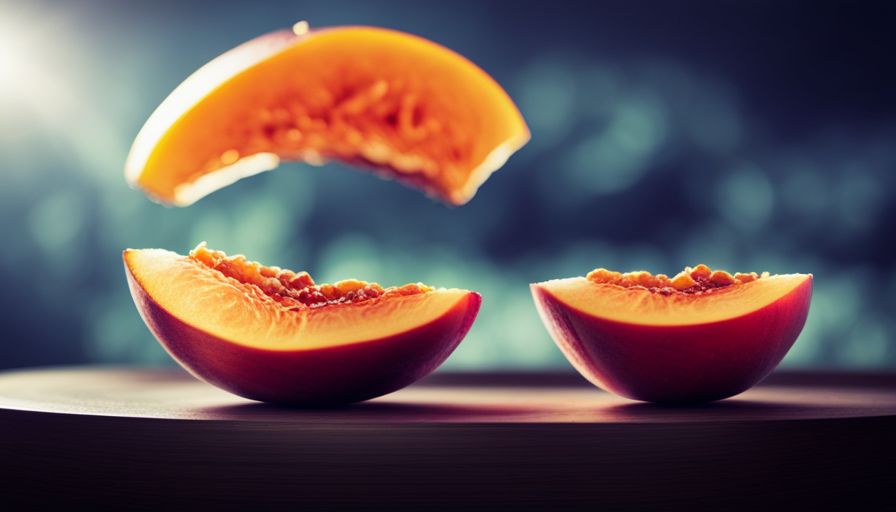Did you realize that consuming just one raw peach can supply you with a substantial dose of vitamins A and C? Indeed, a single peach holds roughly 10% of your daily recommended vitamin A intake and 15% of your daily recommended vitamin C intake. These essential vitamins are important for supporting your overall health and wellness.
Vitamin A is essential for proper vision, immune function, and cell growth, while vitamin C is known for its antioxidant properties and its ability to boost your immune system. Raw peaches are not only delicious but also packed with nutrients that can benefit your body in numerous ways.
In this article, we will explore the nutritional profile of raw peaches, the benefits and functions of vitamins A and C, as well as the antioxidant properties of peaches. Get ready to discover how incorporating raw peaches into your diet can help you achieve optimal health.
Key Takeaways
- Raw peaches are a rich source of vitamins A and C, which are essential for vision, immune function, and cell growth.
- The antioxidants in peaches, including vitamin C, protect against free radicals and reduce the risk of heart disease.
- Peaches are low in calories and high in fiber, making them a good choice for weight loss and maintaining a healthy weight.
- Consuming raw peaches can support respiratory health, reduce inflammation, and have anti-allergic properties.
Nutritional Profile of Raw Peaches
You’ll be amazed at how a raw peach can provide you with a boost of vitamins A and C. Not only are peaches delicious and refreshing, but they also offer a wide range of health benefits.
When it comes to weight loss, peaches are an excellent choice. They’re low in calories and high in fiber, which helps you feel fuller for longer, making it easier to control your appetite. Additionally, peaches are packed with water, which can help with hydration and promote healthy digestion.
In terms of heart health, peaches are a great option as well. They contain potassium, a mineral that helps regulate blood pressure and promote proper heart function. Furthermore, the antioxidants found in peaches, such as vitamin C, help protect against the damage caused by free radicals and reduce the risk of heart disease.
Aside from their nutritional benefits, raw peaches are also a good source of dietary fiber, which aids in digestion and helps maintain a healthy weight. They’re also low in fat and cholesterol, making them a perfect addition to a balanced diet.
Incorporating raw peaches into your diet can have numerous health benefits, including aiding in weight loss and promoting heart health. So next time you’re looking for a nutritious snack, reach for a raw peach and enjoy all the goodness it has to offer.
Vitamin A: Benefits and Functions
One of the benefits of consuming a peach is that it provides an ample amount of Vitamin A. Vitamin A is a fat-soluble vitamin that plays a crucial role in maintaining good vision, promoting healthy skin, and supporting the immune system.
Here are three important benefits of vitamin A:
-
Vision Health: Vitamin A is essential for maintaining good vision. It helps in the formation of a pigment called rhodopsin in the eyes, which is necessary for night vision. Adequate intake of vitamin A can reduce the risk of developing age-related macular degeneration and cataracts.
-
Skin Health: Vitamin A supports the growth and repair of skin cells, keeping your skin healthy and vibrant. It helps in the production of collagen, a protein that gives structure to the skin. Vitamin A also helps regulate oil production, preventing acne and promoting a clear complexion.
-
Immune Function: Vitamin A is vital for a strong immune system. It helps maintain the integrity of the skin and mucous membranes, acting as a barrier against harmful pathogens. It also plays a role in the production and function of white blood cells, which are essential for fighting infections.
In addition to peaches, other good sources of vitamin A include carrots, sweet potatoes, spinach, and liver. Incorporating these foods into your diet can help ensure you meet your daily vitamin A needs and enjoy the numerous benefits it offers.
Vitamin C: Benefits and Functions
Including vitamin C-rich foods like oranges in your diet can help boost your immune system, making you less susceptible to common colds and flu. Imagine being able to enjoy the winter season without the constant sniffles and coughs. Vitamin C plays a crucial role in supporting the immune system and fighting off infections. One of the main benefits of vitamin C is its ability to reduce the severity and duration of the common cold. It does this by enhancing the production and function of white blood cells, which are responsible for fighting off viruses and bacteria.
Additionally, vitamin C plays a vital role in collagen synthesis, which is essential for maintaining healthy skin, bones, and blood vessels. Collagen is a protein that provides structure and strength to various tissues in the body. Without enough vitamin C, collagen production is impaired, leading to weakened skin, brittle bones, and fragile blood vessels.
To better understand the benefits and functions of vitamin C, take a look at the table below:
| Benefits of Vitamin C for the Common Cold | Role of Vitamin C in Collagen Synthesis |
|---|---|
| Reduces severity and duration of colds | Supports healthy skin |
| Boosts immune system | Strengthens bones |
| Enhances white blood cell function | Maintains strong blood vessels |
Incorporating vitamin C-rich foods like peaches into your diet can provide you with these benefits and help you maintain a strong immune system and healthy body.
Antioxidant Properties of Raw Peaches
The antioxidant properties of raw peaches contribute to their potential health benefits and make them a valuable addition to a well-rounded diet. Antioxidants are compounds that help protect our cells from damage caused by harmful molecules called free radicals. Free radicals can cause oxidative stress in the body, leading to various health problems such as chronic inflammation, heart disease, and certain types of cancer.
Raw peaches are rich in antioxidants, particularly vitamin C and beta-carotene. Vitamin C is a powerful antioxidant that helps boost the immune system, promotes wound healing, and protects against oxidative damage. Beta-carotene, which is converted into vitamin A in the body, also acts as an antioxidant and is essential for maintaining healthy skin, vision, and a strong immune system.
Consuming raw peaches regularly can help neutralize free radicals and reduce the risk of chronic diseases. The antioxidants in peaches may also have anti-inflammatory effects, which can further support overall health. Additionally, the high fiber content in raw peaches can aid in digestion and promote a healthy gut.
To reap the maximum health benefits, it’s recommended to consume raw peaches in their whole form, as cooking or processing can reduce the antioxidant levels. Including raw peaches in your diet can be a delicious way to support your overall well-being and enjoy the sweet taste of nature’s antioxidants.
Peaches and Immune System Health
Boost your immune system and enhance your overall health by incorporating the immune-boosting benefits of peaches into your daily diet. Peaches aren’t just delicious, but they’re also packed with essential nutrients that can help support a healthy immune system.
One of the ways peaches contribute to immune system health is through their anti-allergic properties. Allergies occur when the immune system overreacts to harmless substances, leading to symptoms like sneezing, itching, and watery eyes. Peaches contain certain compounds that can help alleviate allergic reactions and reduce inflammation in the body.
Furthermore, peaches have a positive impact on respiratory health. Respiratory conditions, such as asthma and bronchitis, can make it difficult for individuals to breathe properly. Peaches are rich in vitamin C, which has anti-inflammatory properties and can help reduce the severity of respiratory symptoms. Additionally, the antioxidants present in peaches can help protect the respiratory system from oxidative stress, which can contribute to the development of respiratory diseases.
Incorporating raw peaches into your diet can be a delicious and nutritious way to support your immune system and promote respiratory health. Whether enjoyed on their own, added to salads, or blended into smoothies, peaches offer a natural and tasty way to boost your overall well-being. So, next time you reach for a snack, consider grabbing a peach and enjoy the numerous health benefits it has to offer.
Peaches and Skin Health
Indulging in the juicy sweetness of this fruit can nourish your skin and enhance its health. Peaches are not only a delicious treat, but they also offer numerous benefits for your skin. One of the key issues many people face as they age is the appearance of fine lines and wrinkles. Fortunately, peaches can help combat the signs of aging due to their high content of vitamins A and C. These vitamins are powerful antioxidants that protect your skin from damage caused by free radicals, which can accelerate the aging process. Additionally, peaches are rich in vitamin C, which plays a crucial role in the production of collagen, a protein that keeps your skin firm and supple.
Furthermore, peaches can also be beneficial for individuals struggling with acne. Acne is often caused by an overproduction of sebum, a natural oil produced by the skin. Peaches contain vitamin A, which helps regulate sebum production and prevent clogged pores. The fruit also possesses anti-inflammatory properties, reducing redness and swelling associated with acne breakouts.
To provide a comprehensive overview of the skin benefits of peaches, take a look at the table below:
| Skin Benefit | Description |
|---|---|
| Anti-aging properties | Vitamins A and C protect against free radicals and wrinkles |
| Collagen production | Vitamin C helps maintain skin’s elasticity |
| Sebum regulation | Vitamin A controls sebum production |
| Anti-inflammatory | Reduces redness and swelling associated with acne |
Incorporating peaches into your diet can make a significant difference in your skin’s health and appearance. So, why not enjoy a juicy peach and reap the benefits it offers for your skin?
Peaches and Eye Health
Imagine yourself sitting under the shade of a peach tree, savoring the sweet taste of this delightful fruit while knowing that it’s also benefiting your eye health.
Peaches aren’t just delicious but also a great source of nutrients that can contribute to the well-being of your eyes. The high levels of vitamins A and C found in peaches play a crucial role in promoting good eye health.
One of the major benefits of peaches for your eyes is their ability to reduce the risk of macular degeneration. Macular degeneration is a common eye condition that affects the central part of the retina, leading to blurred or loss of vision. The antioxidants present in peaches, particularly vitamin C, help protect the cells in your eyes from damage caused by harmful free radicals. By incorporating peaches into your diet, you can potentially lower the risk of developing macular degeneration and preserve your vision.
Moreover, peaches can also contribute to vision improvement. Vitamin A, found abundantly in peaches, is essential for maintaining good eyesight. This vitamin plays a crucial role in the production of rhodopsin, a pigment located in the retina that aids in low-light vision. Including peaches in your diet can supply your body with the necessary vitamin A, helping to improve your vision and overall eye health.
Peaches offer more than just a delightful taste. Their high content of vitamins A and C make them a valuable addition to your diet, benefiting your eye health by reducing the risk of macular degeneration and contributing to vision improvement. So, next time you enjoy a juicy peach, remember that you’re not only satisfying your taste buds but also nourishing your precious eyes.
Peaches and Digestive Health
Now that we’ve explored how peaches are beneficial for eye health, let’s delve into another aspect of their nutritional value: their impact on digestive health.
When it comes to supporting a healthy gut, peaches are a fruit you shouldn’t overlook. Peaches contain a significant amount of dietary fiber, which plays a crucial role in digestion. Fiber acts as a prebiotic, providing nourishment for the beneficial bacteria in our gut microbiome. These bacteria, collectively known as the gut microbiota, aid in the digestion and absorption of nutrients, as well as support immune function.
The high fiber content in peaches helps regulate bowel movements, preventing constipation and promoting regularity. Additionally, peaches are rich in water, which aids in maintaining proper hydration and promoting smooth digestion.
Furthermore, the antioxidants present in peaches, such as vitamin C, promote a healthy digestive system by reducing inflammation and protecting the gastrointestinal tract from oxidative stress.
So, incorporating peaches into your diet can contribute to a healthy gut microbiome, improve digestion, and support overall digestive health. Whether eaten on their own or added to salads, smoothies, or desserts, peaches are a delicious and nutritious choice for maintaining a well-functioning digestive system.
Incorporating Raw Peaches into Your Diet
One great way to incorporate the natural goodness of peaches into your diet is by enjoying them in their raw form. Raw peaches not only provide a delicious and refreshing snack, but they also offer a multitude of health benefits. Here are four reasons why you should consider incorporating raw peaches into your daily meals:
-
Nutrient Powerhouse: Raw peaches are packed with essential vitamins and minerals, including vitamins A and C. These vitamins play a crucial role in maintaining a healthy immune system, promoting good vision, and supporting overall well-being.
-
Weight Management: Raw peaches are low in calories and high in fiber, making them an excellent choice for those looking to manage their weight. The fiber content helps you feel full and satisfied, reducing the likelihood of overeating.
-
Smoothie Superstars: Adding raw peaches to your smoothies can enhance the flavor and provide a natural sweetness without the need for added sugars. They also contribute to the smoothie’s nutritional value, adding vitamins and antioxidants.
-
Breakfast Delight: Raw peaches can be incorporated into various breakfast recipes, such as overnight oats, yogurt parfaits, or fruit salads. They add a burst of flavor and provide a natural sweetness to start your day on a healthy note.
Incorporating raw peaches into your diet can be a simple and delicious way to boost your nutrient intake and support your overall well-being. So, why not try adding them to your smoothies or experimenting with peach recipes for breakfast? Your taste buds and your body will thank you!
Conclusion: Harnessing the Power of Raw Peaches for Optimal Health
Harnessing the power of raw peaches in your diet is like unlocking a secret treasure trove of health benefits that’ll leave you feeling invincible.
Raw peaches are a fantastic source of vitamins A and C, which are essential for maintaining a strong immune system and healthy skin. Vitamin A plays a crucial role in promoting good vision and supporting the growth and development of cells in the body. Meanwhile, vitamin C is renowned for its antioxidant properties, which help protect the body against damage caused by harmful free radicals.
Including raw peaches in your diet can have numerous benefits for your overall well-being. These delicious fruits are low in calories and fat, making them an excellent choice for weight management. They’re also rich in dietary fiber, which aids in digestion and helps prevent constipation. Moreover, the natural sugars found in peaches provide a quick energy boost, making them a great snack option for athletes or individuals looking to fuel their workouts.
In addition to their vitamins and minerals, peaches contain phytochemicals, such as antioxidants and flavonoids, which have been linked to a reduced risk of chronic diseases like heart disease and cancer. The high water content in peaches also helps keep you hydrated, which is essential for maintaining proper bodily functions.
To harness the power of raw peaches for optimal health, simply incorporate them into your diet by enjoying them as a standalone snack, adding them to smoothies or salads, or using them as a topping for yogurt or oatmeal. So, go ahead and indulge in this juicy and nutritious fruit to unlock the full potential of raw peaches for your well-being.
Frequently Asked Questions
How many calories are in a raw peach?
A raw peach is a low-calorie fruit that provides numerous nutritional benefits. It contains approximately 60-70 calories, making it a great choice for those watching their caloric intake.
Aside from being low in calories, peaches are also rich in vitamins and minerals, such as vitamin A and vitamin C. These nutrients contribute to a healthy immune system, skin health, and overall well-being.
So, including raw peaches in your diet can be a delicious and nutritious way to boost your health.
Can eating raw peaches help prevent certain diseases?
Yes, eating raw peaches can help prevent certain diseases. They contain antioxidants that protect against cell damage and reduce the risk of chronic illnesses like heart disease and cancer. Peaches can be used in smoothies or salads to enhance their nutritional value.
While other fruits like oranges and strawberries are higher in vitamin C, peaches still provide a substantial amount. When it comes to vitamin A, peaches are a good source, but there are other fruits like cantaloupe and mango that contain higher levels.
Are there any potential side effects of consuming raw peaches?
Consuming raw peaches may have potential side effects for some individuals. Allergies to peaches are possible, which could cause symptoms such as itching, swelling, or difficulty breathing. Additionally, some people may experience digestive issues like bloating, gas, or diarrhea after eating raw peaches.
It’s important to note that these side effects aren’t common and most individuals can enjoy raw peaches without any problems. If you have any concerns, it’s best to consult with a healthcare professional.
How do raw peaches compare to other fruits in terms of vitamin A and C content?
When it comes to comparing nutrient content, raw peaches stand tall among other fruits. Just like a shining star in the sky, peaches are packed with vitamin A and C, making them a nutritional powerhouse.
These vitamins play a crucial role in supporting overall health, from boosting the immune system to promoting healthy skin and vision.
So, if you’re looking for a delicious way to enhance your well-being, reach for a juicy raw peach and let its nutrients work their magic.
Can raw peaches be used in cooking or baking, or are they best consumed raw?
Raw peaches can certainly be used in cooking and baking! They’re versatile and can be incorporated into a variety of dishes. From grilling and poaching to making peach salsas or desserts like peach cobbler, there are countless cooking methods and recipes to explore.
The natural sweetness and delicate texture of raw peaches make them a delightful addition to both savory and sweet dishes. So go ahead and experiment with these juicy fruits in your culinary endeavors!
What are the Health Benefits of Eating Raw Peaches?
Eating daily servings of raw peaches can provide numerous health benefits. These delicious fruits are packed with vitamins, minerals, and antioxidants, which can support overall health. Raw peaches are also a great source of dietary fiber and can act as a natural alkalizer in the body, helping to maintain a healthy pH balance.
Conclusion
Congratulations! You’ve just unlocked the secret to optimal health by harnessing the power of raw peaches. These golden gems are not only bursting with vitamins A and C, but they also boast antioxidant properties that protect your body from harmful free radicals.
With the ability to boost your immune system, improve your vision, and enhance digestion, incorporating raw peaches into your diet is a no-brainer. So, why wait? Dive into the juicy goodness and let these sweet treats work their magic on your well-being. Your body will thank you!










